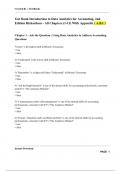Exam (elaborations)
Test Bank Introduction to Data Analytics for Accounting, 2nd Edition Richardson - All Chapters (1-13) With Appendix ( A,B,C) 2024 A+
- Course
- Institution
- Book
Test Bank Introduction to Data Analytics for Accounting, 2nd Edition Richardson - All Chapters (1-13) With Appendix ( A,B,C) 2024 A+
[Show more]




